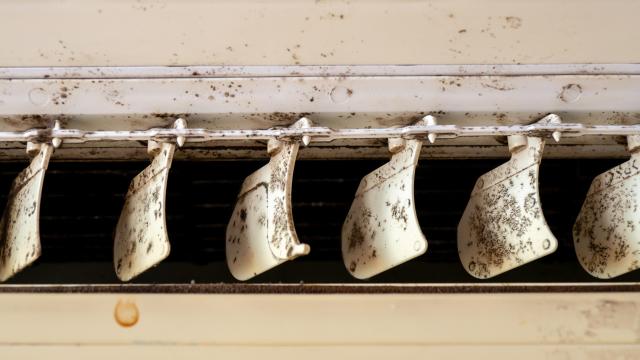Air conditioners make life much easier when the weather is hot. But if your AC unit isn’t well-maintained or functioning properly, or hasn’t been used for an extended period of time, it can provide the ideal environment for mould to grow.
And because mould has the potential to cause or exacerbate various health problems, you don’t want it anywhere in your home — especially in an appliance that expels air. Here’s how to know if there’s mould in your air conditioner, and if there is, what to do about it.
Signs that there could be mould in your air conditioner
Unless there is visible mould on the exterior of your air conditioning unit (like the one pictured above), it’s not always easy to tell if it’s there. Often, the first thing people notice is a musty smell that’s only present when the AC is turned on.
Another potential sign is someone in your household experiencing new or worsening respiratory symptoms — like coughing, wheezing, or shortness-of-breath — or getting more frequent headaches or sore throats. (Although that’s less of a telltale sign, given that there are several different reasons those symptoms could begin or worsen.)
How to tell if there’s mould in your air conditioner
Before doing any type of inspection that may involve mould, it’s a good idea to put a face mask on first, so you don’t end up breathing it in.
Mould on or in your air conditioner could be black, brown, green, white, pink, yellow, or orange in colour. It may also show up as black dust that has accumulated around the air vents.
Even if mould is not visible from the outside of the AC unit, it may be growing inside of it. Here’s how to check:
Window, wall-mounted, or freestanding units
Unplug the AC unit, then remove the front or back grill so you’re able to access the filter. Take the filter out, and look for stains (especially brown, black, and green-ish fuzzy ones), or white or grey-ish powders (which is mildew). If you don’t see any, use a flashlight to inspect the inside for signs of mould and mildew.
Central air conditioning units
Don’t attempt to take anything apart yourself. Instead, shine a flashlight inside the unit, and look or any of the signs of mould and mildew described above on the fan, air ducts, and supply vents. And be sure to check the entire exterior AC unit — including any tight spots next to your house.
What to do if you find mould in your air conditioner
The first thing to do if you spot (or suspect) mould in your air conditioner is to stop using it. This means keeping a window unit switched off, or, if you have central air, not running your HVAC system. This is because continuing to use your contaminated AC could spread mould throughout your home, the EPA explains.
If your window, wall-mounted, or freestanding unit has a substantial amount of mould, the safest thing to do is to get rid of it, unfortunately. But if the mould or mildew appears to be confined to the filter and isn’t that bad, you can either replace the filter, or attempt to clean it. Here’s how to do that:
First, put on a face mask, gloves, and eye protection (if you’re not wearing them already), and remove the filter. Then use a soft-bristle brush (that you don’t mind throwing away after this) to remove any debris and visible mould from the filter. Next, mix a solution of one part bleach to 10 parts water, fully submerge the filter in it, and let it soak for at least 10 minutes. After that, rinse the filter with clean water, and let it air dry.
If you found mould or mildew on your central air conditioning unit, it’s time to call in the professionals — this isn’t something to tackle yourself.

Leave a Reply
You must be logged in to post a comment.